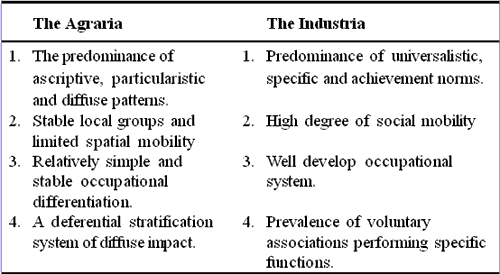(Sample Material of Public Administration Study Kit: Chapter VII - Comparative Public Administration: Riggsian models and their critique
Sample Material of Public Administration Study Kit (Paper - I)
Chapter VII - Comparative Public Administration: Riggsian models and their critique
RIGGSIAN MODEL AND THEIR CRITIQUE
He views administrative process as a system having an environment with which it interacts and in which it operates. It is a corollary of the view that the larger society is a system containing administrative institutions as a sub-system. Riggs has been primarily interested in analysing the interaction between the administrative sub-system on the one hand and the political, social, cultural and economic sub-systems of the society on the other. This speaks of his basic orientation, which is termed as ecological. “Behind such a perspective lies Riggs’s belief that the nature of public administration in any country cannot be understood without grasping the social setting in which it operates.
The Agraria and the Industria
Riggs constructed two models of societies one predominantly industrial called the Industria, and the other predominantly agricultural called the Agraria. These are the two polar types representing contemporary America, and Imperial China respectively. The third category representing the middle of the above two societies was named by him as “transitia”. The main features of the two types were:

Fused-Prismatic-Refracted (later Diffracted)
These models were later abandoned by Riggs in favour of a new scheme of models. As said earlier, Riggs uses structural-functional analysis to explain his constructs of fused, prismatic and refracted societies. These three categories can be broadly identified with traditional or under-developed, developing and developed or industrial societies. He admits that no society completely possesses all the characteristics of his model, and may posses some features of the other category. For example, the Untied States of America is a refracted society, yet it may possess some features of the prismatic type. “The extreme fused and refracted positions are probably not possible and would doubtless also be undesirable."
A society in which a single structure would perform all the functions necessary for the survival of a society may be called a “fused” model. In extreme contrast, there can be a situation in which every function has a corresponding structure that is specialized for its performance. This situation may be called a “refracted” model Riggs points out that we need not think that any real society in this world is fully refracted or fused, but it is fair to say that traditional Siamese society was quite fused, and American society is rather refracted. It would be a mistake to think of the fused and refracted models as a dichotomy. A mid-point between the two extremes or polar types, may be called the “prismatic” model. Most of the developing countries in which there is a mixture of traditional and modern, industrial characteristics exist side by side with agricultural, are prismatic.
Prismatic Society
The focus of Rigg’s analysis of the study of certain key elements of the social structures in a prismatic society, and their interaction with the administrative sub-system of that society described by him as “Sala”. A prismatic society is characterized by “selectivism” (intermediate category between universalism and particularism), “attainment” (intermediate category between achievement and ascription), and “poly-functionalism” (intermediate category between functional specificity and functional diffuseness). The basic characteristic of prismatic society are:
1. Formalism
At the administrative level appear intra-bureaucratic politics and ritualization of procedures. This happens because bureaucrats have no clear sense of the goals and policies to be’ accomplished. There is no effective political control over the bureaucracy. The officials take their own decisions. The prevalence of formalism encourages corruption. The ability of an official to insist on the letter of the law and regulations gives him a weapon in dealing with a private citizen which he can often use for his personal advantage. The process of recruitment into public services is “attainment” oriented- it falls between ascription and achievement as a criterion.’ Riggs explains that attainment criteria, although they look like achievement criteria, they can also be considered a disguised form of ascriptive criteria.
2. Heterogeneity
A prismatic society is characterised by a high degree of heterogeneity which means “the simultaneous presence, side by side, of quite different kinds of systems, practices and view points.” In contrast, the “fused” and “refracted” models are relatively homogeneous. In prismatic society there exist urban areas with a sophisticated intellectual class, Western style offices and the modern gadgets of administration. Side by side there exist rural areas possessing traditional looks and outlooks, with village heads or “elders” combining various political, administrative, religious and social roles. Heterogeneity applies not only to the society as a whole, but it applies also to the public administration.

